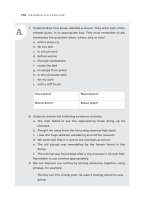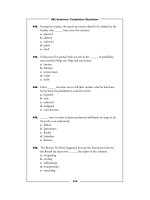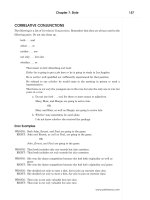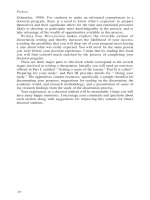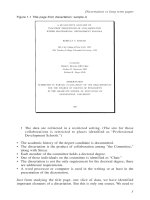Writing your doctoral dissertation - part 25 ppt
Bạn đang xem bản rút gọn của tài liệu. Xem và tải ngay bản đầy đủ của tài liệu tại đây (48.45 KB, 5 trang )
Analyzing and interpreting your data
120
in that it focuses your attention on one sub-set of your study. It frequently
enables you to study more manageable data sets sequentially rather than
simultaneously.
Thus, if you are looking at teachers’ and students’ perceptions of learning,
you may first analyze your data from the teachers. After you have completed
your review of the “teacher data,” you may start on the students’ data, applying
the insights and expertise you developed in your first go-around’. Subsequently
your review of teachers’ data may incorporate the new insights you developed.
Throughout the process of analyzing your data be cautious of losing sight
of the forest by focusing on individual trees. Connect each analytical process
with a research question and multiple databases, insuring that you are not
analyzing in isolation from your intended goal. Documenting your analytical
processes in written notes both provides “grist for the mill” when you are
ready to write your section on the processes you implemented, and promotes
your understanding of what you have done and what else you might want to
try. This effect of writing is so subtle that one respondent commented:
I didn’t see the writing as analyzing the data. I saw it as writing. And yet, now
I can talk about my study and analysis, not my writing. There were moments
during the writing process, when data analysis led to the discovery of insights.
While much of the dissertation writing process was measured and slow-going,
it was moments of discovery that led to spurts of exhilaratingly insightful
writing. These analytical discoveries propelled the dissertation process forward.
Reducing Your Data
You need to transform your raw data into a format that will facilitate your
analysis. This transformation may take several steps. You may note the
presence or absence of specific words. You may note the number of correct
responses. You may create a verbal transcript from a video-tape. These are
all “first-level” analyses. You will need to work on each of these further, from
a quantitative and/or a qualitative perspective. This process is frequently
referred to as reducing your data because you will create groupings and
combine separate sheets of paper from each subject, creating, for example, a
single page with all the information you need.
The analysis of your data may take many forms, some of which may utilize
technology. You may tally your responses by hand, or access a computer
program with coded answer sheets. You may also select time-intensive human
interrogation of the data to discover what you have found.
Finding Patterns in Your Data
Whether you are analyzing your data from a qualitative or a quantitative
standpoint, you will look for patterns in your data. There are numerous excellent
Analyzing and interpreting your data
121
resources to guide your analytical processes. Selected references are listed in
Appendix D. As you go through this intense process, try to remember that you
will need to offer expansive explanations for all the decisions you make, both in
your dissertation and at your oral defense. Some of these decisions may be about
the statistical tests which you have selected. Others may focus on the processes
you implemented in identifying patterns of response. As you become conscious
of the decisions you are making, ask yourself to explain your rationale. If you
are as critical of your own responses as your committee and external readers may
be at your orals, you will be preparing for the predictable questions which will
occur as you “go public” with your study.
Quantitative Strategies
Quantitative analysis typically refers to counting specific “units of analysis,”
as designated, for example, in your research question. In quantifying your
data, you may find it useful to create a series of tables. Each table might note
such data as the individual scores by grade or number of words in each essay.
Data displays might include:
• tabulating the number of responses to each question;
• tabulating the number of correct responses to each question;
• listing the frequency of appearance of topics addressed in documents;
• listing scores by age or grade level;
• tabulating the number of respondents who offered each answer;
• comparing numerical data across events or participants;
• or comparing scores on a standardized test to scores on a researcher-
created examination.
You might ask, “How do I know when to stop my data analysis?” The
response is fairly straightforward in studies which identify a statistical test as
the focus: for example, that there is no statistical difference between the
scores on the SAT-history test of students who wrote a two-minute quick-
write everyday in history class and those who did not. Depending on such
issues as your sample size, you will select an appropriate statistical test.
Completing the statistical tests may include graphing data and translating the
numbers into visually informative graphs and charts.
It is not unusual for “outside experts [to] use more elaborate statistical
procedures than are appropriate.” Your dissertation is typically a first-level
research study. Usually doctoral students are not expected to be as proficient
as experienced researchers who may have conquered more sophisticated
analytical processes. Draw on university resources and check with your
committee. Don’t have the consultant act as a shadow committee.
The computer printouts may look like Greek to one who does not understand
statistics, but to a statistician there is usually no problem. … Sometimes the
Analyzing and interpreting your data
122
printouts do not have the complete program. One student discovered, after
several tries, that she had used the wrong program to analyze her data.
Somewhere along the way, someone had suggested the wrong program and
she had to go back to the drawing board to determine an appropriate program.
If any phase of the process can be downright frustrating or confusing, it is this
phase. One very simple error can cause one to lose a lot of time.
(Smith, 1982, p. 41)
Qualitative Strategies
Qualitative strategies usually focus on identifying frequently occurring
phenomena. These phenomena are often called patterns of behavior. The
behavior may be verbal or nonverbal. Qualitative researchers will frequently
design scoring rubrics which characterize the specific data which were
collected in their study. Typically the researcher develops unique categories
through a series of cyclical processes, reducing the categories to both discrete
and representative patterns found in the range of data collected.
Sample patterns may include:
• the range of topics discussed in the journal entries;
• samples of each topic discussed in the journals;
• typical participant responses to a short-answer test;
• participant actions in different settings;
• interactions in different settings; or
• language used in different contexts.
When doing a hypothesis-generating study you will find patterns, repetitions,
commonalities. These are not simply repeated words, but concepts and/or
processes which recur in your data, and hypothetically predictable in a larger
and more random data pool. Some researchers use computer software such
as Ethnologue and Nud-ist (Nonnumerical Unstructured Data-Indexing,
Searching and Theorizing). These programs are intended to facilitate the
process of data analysis by searching for specific words or phrases. While
these programs do provide support for developing graphs and charts of
repeated words and groups of words, they do not have the human capacity to
identify synonymous words, for example. If the purpose of your study is to
note the frequency of specific word choices, these tools may be very useful
for you. In much of qualitative research the goal is to note the intent of the
speaker or writer, which makes the applicability of such programs to
qualitative studies more limited.
The patterns represent both a quantitative element and a qualitative
element in the research. The patterns may be identified, for example, because
of their frequent occurrence in the data. The qualitative component of these
patterns may be realized, for example, in the presentation of typical samples
of the phenomenon under investigation.
Analyzing and interpreting your data
123
Interpreting Your Findings
One major problem at this point becomes that of the researcher making more
claims for the research than can be supported by the data. It is important to
make inferences and generalizations, but unsupported generalizations and
claims must be avoided.
(Smith, 1982, p. 41)
It is important for you to keep three components of your study in mind as
you interpret your findings:
1 Your initial research questions.
2 Your sample (with its limitations).
3 Your data analysis.
You want to answer your initial research questions within the context of the
specific sample you focused on in your data collection. If your study was
initially intended to test a hypothesis, your study should report the results of
that testing. A typical outcome is the support of the original hypothesis or
the lack of support of that hypothesis. Either finding is important.
If your study supported the original hypothesis (if it was a positive
directional hypothesis supporting a particular theory, for example), this
finding suggests the robustness of the theory which you were testing. On the
other hand, if your study fails to support the original, hypothesis, that does
not mean that this theory is invalid. Nor does it mean that your study was not
good. Rather, the theory may, for example, apply to a sub-set of our
population instead of being universally applicable. All carefully crafted
research provides us with important information which allows us to have
greater confidence in a theory, or which encourages us to re-think that theory
more carefully. Either way, it provides us with useful information.
Knowing What You Found
Your goal in conducting this analysis is to figure out what you have found.
You will scrutinize your data, interrogate your data, in the hopes of
discovering what your data mean, or more precisely, what meaning you can
make of your data.
When conducting tests of statistical significance, do not dismiss findings
which are not “statistically” significant. Statistical significance is one way of
identifying a potentially important finding. Researchers who equate statistical
significance with significance per se may have lost sight of the true purpose
of research. All findings are potentially useful and significant, regardless of
whether they are “statistically significant.”
In your roles as researcher and writer of your research report, you will
want to find ways to understand your data, comparing sub-sets of your data,
Analyzing and interpreting your data
124
comparing your data with other studies, and comparing your data with the
theories which contributed to your study’s design. These comparisons may
be displayed graphically, providing your readers with a context in which to
interpret your findings. The adage that “one picture is worth 1,000 words,” is
useful to remember in this regard.
As you analyze your data, you may create some figures or tables to display
your data in such a way that your readers will clearly see the issues which
you are discussing. These graphic organizers are distinguished from one
another by the American Psychological Association APA:
• Tables are typeset, rather than photographed from artwork supplied by the
author. Tables are frequently used to present quantitative data.
• Figures are typically used to “convey structural or pictorial concepts.” The
types of figures can vary: graphs (line graphs, bar graphs, circle or pie
graphs, scatter graphs, and pictorial graphs), charts, dot maps, and
drawings. A figure may be a chart, graph, photograph, or a drawing: “Any
illustration other than a table is called a figure” (APA, 1994, p. 141).
A few samples may prime your mind to think of informative ways to present
your data. Look over the preceding chapters, noting the ways in which tables
and figures clarified concepts and issues. Contemplate similar data
presentations from your analysis of your own data.
As you become more familiar with your data and your findings start to
emerge, you will find it useful to create a few such visual presentations.
These graphic images will contribute to your understanding of your data, and
thereby lead you to identify your unique “findings.” They will also enable
your readers to envision your findings. Readers of dissertations are frequently
drawn to such displays of information, which typically synthesize the key
findings of the study. They may subsequently read the text which
accompanies the drawings. Alternatively, they may request your verbal
explanation as a way to engage you in conversation about your study at pre-
oral conferences with your committee, at your orals, and/or at professional
poster sessions on research. Thus, the potential usefulness and importance of
these displays suggests a need to dedicate time and care to creating them.
Miles and Huberman (1994), among others, have provided excellent guidance
in the development of visual displays of information. Once you have
displayed your data visually, you are ready to start the challenging process
of interpreting what each display means individually, and what the totality of
your data mean. In addition, consider creating a figure or table which
synthesizes your findings figuratively and/or literally.
Frequently doctoral students find that they “hop” between analyzing their
data, and determining what their findings are. This process is particularly
important for those who carry out hypothesis-generating research studies. As
the researcher starts to make some generalizations from the data, moving
towards a hypothesis, she or he will return to those data to seek confirmation
of the emerging hypothesis. In this scenario, then, data analysis and

